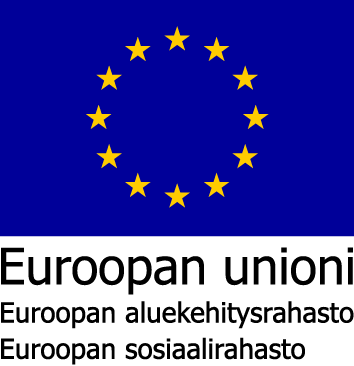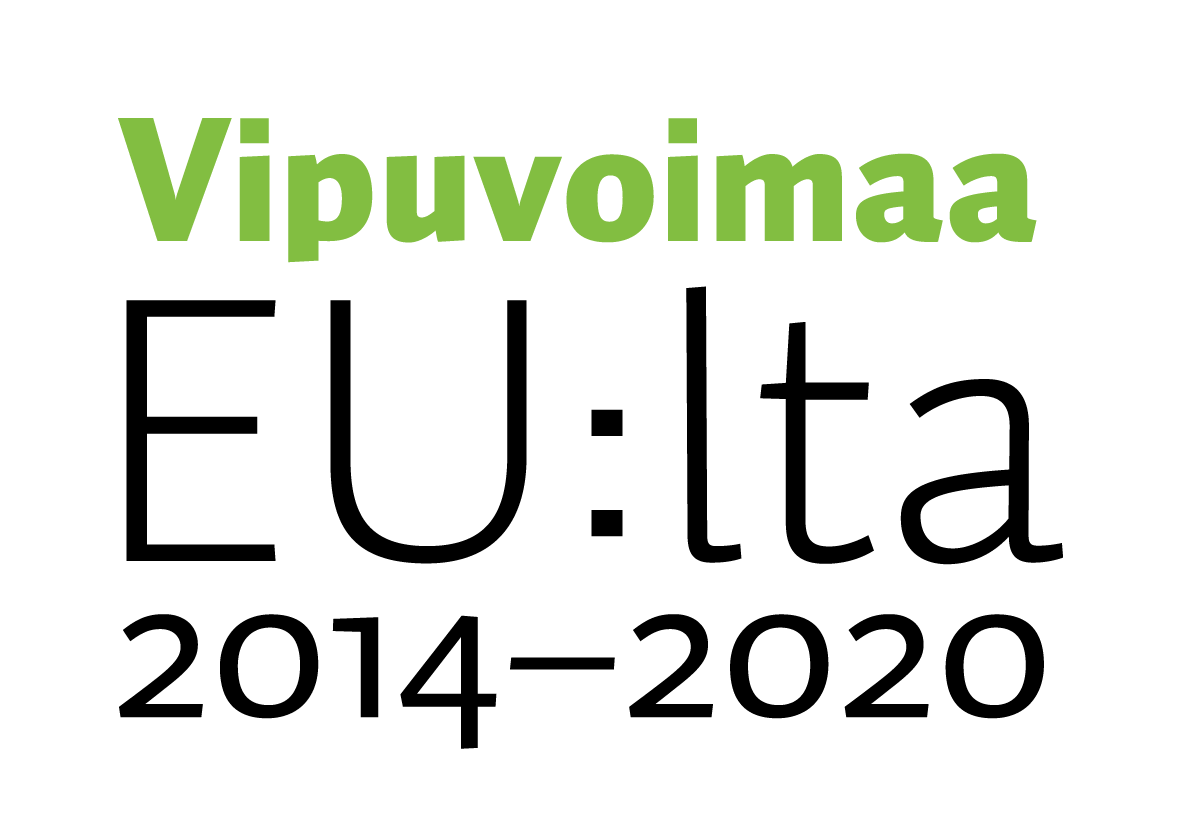

 |
 |
Hankekoodi: S20515
Hankkeen nimi: Hyvä alku Pohjanmaalla - En bra start i Österbotten
Toimintalinja: 3. Työllisyys ja työvoiman liikkuvuus
Erityistavoite: 6.1. Nuorten ja muiden heikossa työmarkkina-asemassa olevien työllistymisen edistäminen
Suunnitelman mukainen toteutusaika: Alkaa 1.1.2016 ja päättyy 31.12.2018
Toiminnan tila: Toiminta päättynyt
Vastuuviranomainen: Hämeen elinkeino-, liikenne- ja ympäristökeskus
Hakijan virallinen nimi: Pohjanmaan liitto kuntayhtymä
Organisaatiotyyppi: Kuntayhtymä
Y-tunnus: 0970063-6
Jakeluosoite: Hietasaarenkatu 6B
Puhelinnumero: 06 320 6500
Postinumero: 65100
Postitoimipaikka: Vaasa
WWW-osoite: http://www.obotnia.fi
Hankkeen yhteyshenkilön nimi: Johanna Leppänen
Yhteyshenkilön asema hakijaorganisaatiossa: ----
Yhteyshenkilön sähköpostisoite: johanna.leppanen(at)obotnia.fi
Yhteyshenkilön puhelinnumero: +358 44 366 4148
Hakijoiden lukumäärä tai tuen siirto -menettely:
Hankkeen tavoitteena on kehittää maahanmuuttajien alkuvaiheen kotoutumista ja osallisuutta edistävä alueelliseen ja kansalliseen käyttöön soveltuva toimintamalli, jonka avulla tavoitetaan kaikki maahanmuuttajaryhmät ja vastaavat heidän tarpeisiinsa. Tavoitteena on myös nostaa esille ne mahdolliset kotoutumista hidastavat tai ehkäisevät tekijät, joihin kunnissa ja alueilla on löydettävä rakenteelliset ratkaisut tai jotka edellyttävät kansallista toimintatapaa ja mahdollisesti myös yhteistä rahoitusmallia.
Seitsemää osatavoitteita toteutetaan soveltavasti eri Pohjanmaan seutukunnissa lähtien kunkin seutukunnan ja kunnan erityistarpeista. Hankkeen kehittämistyöstä saatavat kokemukset, sen toiminnot ja tulokset ovat kuitenkin hankeaikana koko maakunnan ja kuntien käytössä ja hankekauden jälkeen myös levitettävissä kansallisesti.
Hankkeessa pyritään mahdollisimman pitkälle hyödyntämään sekä Pohjanmaalla, kansallisesti ja tarpeen vaatiessa myös pohjoismaisesti tehdyn kehittämistyön tuloksia ja niissä kehitettyjä näyttöön perustuvia hyviä käytäntöjä. Vastaavasti varmistetaan, että Hyvä alku Pohjanmaalla -hankkeessa kehitettäviä ja räätälöityjä käytäntöjä levitetään tehokkaasti ja niitten soveltuvuutta testataan kaikissa Pohjanmaan osahankkeissa.
Hankkeessa tuotetaan Pohjanmaan toimijoiden yhtenäinen, kaksikielinen alkuvaiheen ohjauksen ja neuvonnan toimintamalli ja kehitetään palvelukokonaisuus, joka on kaikkien maahanmuuttajien saatavilla. Hankkeessa on kehitetty prosessi, joka varmistaa, että tarpeen mukaan kotouttamislain mukaisesti kaikille maahanmuuttajille tehdään alkukartoitus ja että sen pohjalta laaditaan yksilöllinen ja seurattava toimenpidesuunnitelma. Hankkeessa on palvelukokonaisuuden avulla kehitetty laaja-alaista yhteistyötä ja selkiytetty eri toimijoiden vastuita ja tehostettu olemassa olevien resurssien hyödyntämistä. Hankkeessa on asiakaslähtöisesti kehitetty ensivaiheen yhteiskunta- ja kielikoulutuksen moduuli eri kohderyhmille. Hankkeessa on lisäksi suunniteltu ja toteutettu omakielisten hyvinvointi- ja yhteiskuntaneuvojien koulutuskokonaisuus sekä kehitetty toimintamalli neuvojien alueelliselle hyödyntämiselle. Projektin ansiosta on myös luotu yhteistyömalli, joka auttaa kuntia saamaan kyllin ajoissa tiedon yrityksiin rekrytoitavista maahanmuuttajista, jotta kunnat pystyvät järjestämään heidän tarvitsemansa palvelut heti maahantulon jälkeen. Hankkeen toiminnoilla edistetään maahanmuuttajien työllistymistä ja tuetaan heidän siirtymistä koulutuksesta työelämään tai muihin palveluihin.
Hankkeen toimenpiteissä kiinnitetään huomiota sukupuolten väliseen tasa-arvoon siten, että kehitettävässä palvelukokonaisuudessa huomioidaan maahanmuuttajanaisten ja -miesten elämäntilanteet ja niiden vaikutukset palveluihin hakeutumiselle, ensivaiheen neuvonnan ja ohjauksen saamiselle ja työllistymiselle. Toimenpiteiden avulla pyritään vaikuttamaan niihin tekijöihin, jotka estävät tasa-arvon toteutumista vahvistamalla sitä edistäviä tekijöitä.
Kaikki eri ikäiset ja eri syistä tulleet, ensisijaisesti kotoutumisen alkuvaiheessa olevat maahanmuuttajat: työn, perheen tai opiskelun takia saapuneet, pakolaiset ja turvapaikanhakijat. Pääasiallinen fokus on nykytilanteessa usein palveluiden ulkopuolelle jäävissä ryhmissä (muut kuin TE-toimiston asiakkaat, perhesyistä saapuneet, opiskelijat, kotiäidit, nuoret, vammaiset, ihmiskaupan uhrit).
Pohjanmaan yritykset ja muut työnantajat sekä oppilaitokset, järjestöt ja Pohjanmaan tulkkikeskus. Lisäksi Pohjanmaan TE-toimisto, Pohjanmaan ELY-keskus ja kunnat välillisesti, kun maahanmuuttajien palvelutarve vähenee muiden kuin kotoutumispalvelujen osalta.
Myönnetty EU- ja valtion rahoitus: 759 000
Toteutunut EU- ja valtion rahoitus: 712 675
Suunniteltu julkinen rahoitus yhteensä: 952 154
Toteutunut julkinen rahoitus yhteensä: 906 907
Maakunnat: Pohjanmaa
Seutukunnat: Jakobstadsregionen, Vaasan, Kyrönmaan, Sydösterbottens kustregion
Kunnat: Kaskinen, Vöyri, Pedersören kunta, Uusikaarlepyy, Mustasaari, Pietarsaari, Kristiinankaupunki, Kruunupyy, Laihia, Luoto, Isokyrö, Vaasa, Maalahti, Närpiö, Korsnäs
Jakeluosoite:
Postinumero:
Postitoimipaikka:
Suunniteltu: 71
Toteutunut seurantatietojen mukaan: 23
Suunniteltu: 780
| Välitön | Välillinen | |
| Ekologinen kestävyys | ||
| Luonnonvarojen käytön kestävyys | 0 | 0 |
| Hankkeella ei ole tunnistettuja välittömiä tai välillisiä vaikutuksia luonnonvarojen käyttöön. | ||
| Ilmastonmuutoksen aiheuttamien riskien vähentäminen | 0 | 7 |
| Ensivaiheen ohjausta ja neuvontaa kehitettäessä ympäristönäkökulma huomioidaan osana yhteiskuntatietoisuutta siten, että ihmisillä on tarvittava tieto omien valintojen vaikutuksesta ilmastonmuutokseen. | ||
| Kasvillisuus, eliöt ja luonnon monimuotoisuus | 0 | 0 |
| Hankkeella ei ole tunnistettuja välittömiä tai välillisiä vaikutuksia kasvillisuuteen, eliöihin tai luonnon monimuotoisuuteen. | ||
| Pinta- ja pohjavedet, maaperä sekä ilma (ja kasvihuonekaasujen väheneminen) | 0 | 0 |
| Hankkeella ei ole tunnistettuja välittömiä tai välillisiä vaikutuksia pinta- ja pohjavesiin, maaperään tai ilmaan. | ||
| Natura 2000 -ohjelman kohteet | 0 | 0 |
| Hankkeella ei ole tunnistettuja välittömiä tai välillisiä vaikutuksia Natura 2000 -ohjelman kohteisiin. | ||
| Taloudellinen kestävyys | ||
| Materiaalit ja jätteet | 0 | 7 |
| Ensivaiheen ohjausta ja neuvontaa kehitettäessä ympäristönäkökulma huomioidaan osana yhteiskuntatietoisuutta siten, että ihmisillä on tarvittava tieto mm. kierrätyksestä ja sen vaikutuksesta ympäristöön. | ||
| Uusiutuvien energialähteiden käyttö | 0 | 0 |
| Hankkeella ei ole tunnistettuja välittömiä tai välillisiä vaikutuksia uusiutuvien energialähteiden käyttöön. | ||
| Paikallisen elinkeinorakenteen kestävä kehittäminen | 9 | 9 |
| Projektin tavoitteena on edistää maahanmuuttajataustaisten työllistymistä ja varmistaa Pohjanmaan avainalojen työvoiman saatavuus. | ||
| Aineettomien tuotteiden ja palvelujen kehittäminen | 8 | 8 |
| Hankkeen toiminnassa hyödynnetään olemassa olevia resursseja ja kehitetään työllistymistä tukevia palveluita mm. maahanmuuttajille suunnattujen ensivaiheen kieli- ja yhteiskuntatietoisuutta lisäävillä räätälöidyillä koulutuskokonaisuuksilla. Hankkeessa kehitetään omakielistä informaatiota mm. kouluttamalla hyvinvointi- ja yhteiskuntaneuvojia ja kehitetään keinoja neuvojien palveluiden alueelliselle hyödyntämiselle. | ||
| Liikkuminen ja logistiikka | 0 | 7 |
| Lähipalveluiden tehokkuudella ja toimivuudella vähennetään kuljetus- ja liikkumistarpeita, mikä lisää hankkeen energiatehokkuutta ja vähähiilisyyttä. | ||
| Sosiaalinen ja kulttuurinen kestävyys sekä yhdenvertaisuus | ||
| Hyvinvoinnin edistäminen | 9 | 9 |
| Hankkeen toiminnalla on vaikutusta maahanmuuttajien hyvinvointiin. Kehittämällä kaikkien maahanmuuttajien saatavilla oleva palvelukokonaisuus, johon sisältyy alkukartoitus ja ensivaiheen kieli- ja yhteiskuntatietoisuus, varmistetaan tiedon saatavuus. Tiedon saaminen on demokraattisen yhteiskunnan perusedellytys, ja varmistamalla tämän tiedon saatavuus edistetään maahanmuuttajien hyvinvointia, osallisuutta ja työllistymistä. | ||
| Tasa-arvon edistäminen | 9 | 9 |
| Hanke edistää maahanmuuttajien ja kantaväestön tasa-arvoa ja lisää heidän mahdollisuuksia toimia yhteiskunnan ja yhteisön täysvaltaisina jäseninä. Hanke edistää myös sukupuolten tasa-arvoa tunnistamalla sukupuolen mahdolliset vaikutukset maahanmuuttaneiden palveluiden saatavuuteen. | ||
| Yhteiskunnallinen ja kulttuurinen yhdenvertaisuus | 9 | 9 |
| Hanke edistää yhteiskunnallista ja kulttuurista yhdenvertaisuutta kehittämällä maahanmuuttajien ensivaiheen kieli- ja yhteiskuntatietoisuuden saatavuutta, mikä vuorostaan lisää maahanmuuttajien mahdollisuuksia toimia yhteiskunnan tasa-arvoisina jäseninä. Alkukartoitus ja sen pohjalta tunnistettavat palvelutarpeet edistävät osallisuuden ja työllistymisen mahdollisuuksia ja monikulttuurisen ja tasa-arvoisen yhteiskunnan kehittymistä. | ||
| Kulttuuriympäristö | 0 | 8 |
| Hanke edistää kulttuuriympäristön hyödyntämistä lisäämällä maahanmuuttajien tietoisuutta Pohjanmaan kulttuuriperinnöstä ja virkistymisalueiden tarjoamista mahdollisuuksista. | ||
| Ympäristöosaaminen | 0 | 8 |
| Ensivaiheen ohjausta ja neuvontaa kehitettäessä ympäristöosaaminen huomioidaan osana yhteiskuntatietoisuutta siten, että ihmisillä on tarvittava tieto ympäristöstä ja siihen vaikuttavista tekijöistä. | ||
Hyvä alku Pohjanmaalla hanketta koordinoi Pohjanmaan liitto. Osatoteuttajina toimivat Vaasan kaupunki, Vamia, Svenska Österbottens förbund för utbildning och kultur samkommun/yrkesakademin, Pietarsaaren seudun kotouttamisyksikkö ja Kust-Österbottens samkommun för social- och primärhälsovård (K5). Hankkeen toiminta-aika oli 1.1.2016 – 31.12.2018.
Hanke oli osa valtakunnallista Kotona Suomessa –kokonaisuutta ja se osallistui valtakunnalliseen kehittämistyöhön toimimalla alkuvaiheen kotouttamisen palvelumallin valmistelleessa työryhmässä. Hyvä alku Pohjanmaalla-hankkeen tavoitteena oli kehittää maahanmuuttajien alkuvaiheen kotoutumista ja osallisuutta edistävä toimintamalli, jonka avulla tavoitetaan kaikki maahanmuuttajat ja varmistetaan se, että heille tarjotut palvelut vastaavat heidän tarpeitaan. Hankkeen päätavoite koostui seitsemästä osatavoitteesta, joita toteutettiin soveltavasti eri Pohjanmaan seutukunnissa lähtien kunkin seutukunnan ja kunnan erityistarpeista. Hankkeen kehittämistyöstä saadut kokemukset, sen toiminnot ja tulokset olivat kuitenkin koko maakunnan ja kuntien käytössä.
Hankkeessa tehtiin alkuvaiheen kotoutumista tukevien palveluiden nykytilakartoitus SWOT-analyysien avulla, joiden pohjalta pyrittiin toisaalta tunnistamaan tärkeimmät ongelmakohdat sekä kehittämistyön kannalta tärkeitä yhdyspintoja eri toimijoiden välillä. Laajan toimijakentän ja hankekokonaisuuden tueksi otettiin käyttöön Skotlannissa kehitetty ja myös kansainvälisesti hyödynnetty kotoutumisen käsitteellinen viitekehys (Ager, A. & Strang, A. (2008) Understanding Integration. A Conceptual Framework). Viitekehys tunnista kotoutumisen kannalta keskeiset tekijät ja se tekee näkyväksi kotoutumisen kompleksisuuden ja auttaa hahmottamaan kotoutumisen kaksisuuntaisuutta. Viitekehys tuki laaja-alaista yhteistyötä ja sen avulla selkiytettiin eri toimijoiden vastuita kotoutumista edistävässä työssä.
Hankkeen tuloksena syntyi alkuvaiheen kotoutumista tukevia toimintoja ja palveluita. Hankkeessa perustettiin seudullinen matalan kynnyksen periaatteella toimiva neuvontapiste ”Kotouttamisportti”, joka palvelee eri syistä seudulle muuttavia maahanmuuttajia. Neuvontapisteessä maahanmuuttaja saa neuvoja ja apua kotoutumisen ja asettumisen kannalta tärkeissä asioissa ja tarvittaessa hänet ohjataan oikean palvelun piiriin. Kotouttamisportin työtä tukee selkeät palveluketjut ja niiden prosessikuvaukset sekä omankieliset materiaalit keskeisistä palveluista. Hankkeessa kehitettiin myös maahanmuuttajien vastaanottoa tukeva toimintaohje.
Hankkeessa kehitetiin yhteiskuntatietoutta ja kielenopetusta antava 10 viikon pituinen koulutusmoduuli kotouttamiskoulutukseen pääsyä odottaville ja työelämän ulkopuolella oleville maahanmuuttajille. Yhteiskuntatietous toteutetaan tulkin välityksellä ja moduuli sisältää myös kieliopintoja. Hankkeessa kehitettiin ja pilotoitiin omakielinen yhteiskunta- ja hyvinvointineuvojakoulutus. Koulutus toteutetaan monimuoto-opetuksena ja se kestää lukuvuoden. Koulutukseen osallistuneet henkilöt ovat kieltä jo osaavia maahanmuuttajataustaisia henkilöitä, jotka koulutuksen jälkeen pystyvät tarjoamaan yhteiskuntaorientaatiota uusien maahanmuuttajien omalla kielellä. Sekä yhteiskuntatietousmoduulin kehittämisessä, että yhteiskunta- ja hyvinvointineuvojakoulutuksessa hyödynnettiin jatkuvasti osallistujilta saatavaa palautetta niin, että niiden sisältö vastaisi mahdollisimman hyvin maahanmuuttajien tarpeita.
Hankkeessa kehitettiin viranomaisten ja maahanmuuttajia työllistävien yritysten välistä yhteistyötä maahanmuuttajien tavoittamiseksi ja heidän ohjaamiseksi oikeiden palveluiden piiriin. Tässä yhteistyössä hyödynnettiin myös yhteiskunta- ja hyvinvointineuvojia.
Merkittävä osa Pohjanmaalle saapuvista maahanmuuttajista sijoittuu ruotsinkielisiin kuntiin ja heidän kotoutumiskielensä on ruotsi. Hankkeessa kehitettiin suomenkielistä Testipiste.fi-materiaalia mukaillen vastaava testipatteristo. Testi sisältää sekä kielen eri osa-alueiden mittaamiseen tarkoitettuja testejä sekä oppimisvalmiuksien ja mahdollisten oppimisongelmien tunnistamiseen tarkettuja testejä.
Hankekausi osui ajallisesti kiivaimmillaan olleen maakunta- ja sosiaali- ja terveyspalveluiden uudistamiseprosessiin. Hankkeen koordinoija, Pohjanmaan liitto, oli vahvasti mukana tässä uudistamistyössä ja näin ollen myös koko hanketiimi osallistui eri tavoin uudistustyöhön. Haasteena oli kehittää toimintoja niin, että ne toimivat tulevista rakenteista riippumatta. Hallituksen ehdotuksen laiksi kotoutumisen tukemiseksi pohjalta hankkeessa kehitettiin ehdotus alueellisen yhteistyön toimintamalliksi, missä keskeisenä elementtinä kotouttamistyöstä alueellisesti vastaavan toimijan ja kunnissa ja seutukunnissa tehtävän kotouttamistyön välillä on maahanmuuton ja kotoutumisen yhteistyöryhmä tai neuvottelukunta. Yhteistyöryhmän tehtävänä on maahanmuuton ja kotouttamisen alueellinen suunnittelu, kehittäminen, toimeenpanon seuranta, yhteensovittaminen maakunnan aluekehityksen, elinvoiman ja kansainvälistymisen sekä terveyden ja hyvinvoinnin edistäminen, yhdenvertaisuuden ja hyvien väestösuhteiden edistäminen sekä yhteiset kotouttamisen ohjelmien laatiminen. Tuleva maakunta olisi lakisääteisten tehtäviensä pohjalta vastannut neuvottelukunnan asettamisesta ja yhteistyöstä. Uudistuksen kaaduttua maahanmuuton alueellinen koordinaatiovastuu on ELY-keskuksella. Pohjanmaan ELY-keskus kehittää ehdotettua rakennetta edelleen osana maahanmuuton ja kotouttamisen tehtäväänsä ja uuden Pakolaisten ohjauksen kehittämine-hankkeen toteutusta. Myös kotoutumisen käsitteellinen viitekehys tulee jatkossa olemaan yksi työkalu tässä työssä.
Hankkeessa kehitetyt toiminnot ovat juurtuneet osaksi paikallisten ja alueellisten taustaorganisaatioiden rahoittamaa ja toteuttamaa toimintaa ja niiden jatkokehittäminen ja hyödyntäminen tulee jatkumaan paikallisen, seudullisen ja alueellisen yhteistyön kautta.
Viranomainen on merkinnyt hankkeen esimerkkihankkeeksi